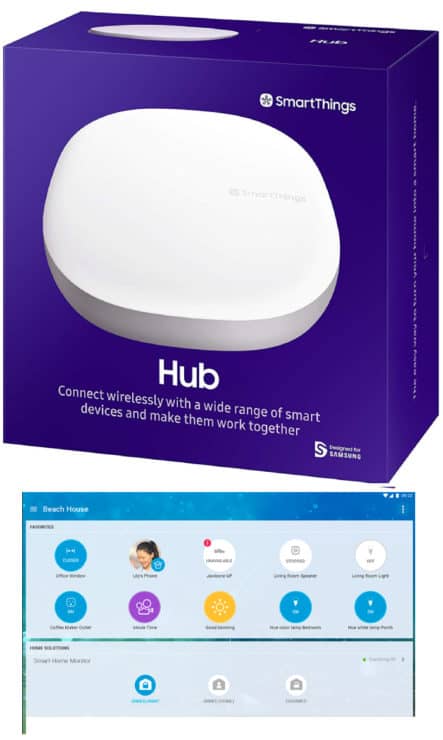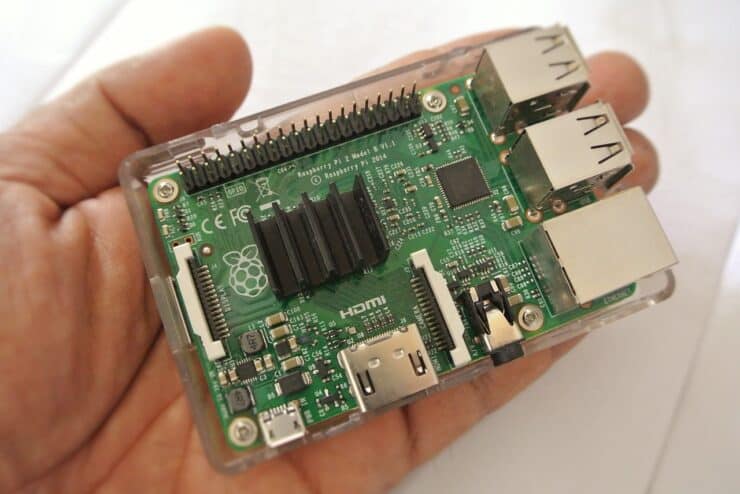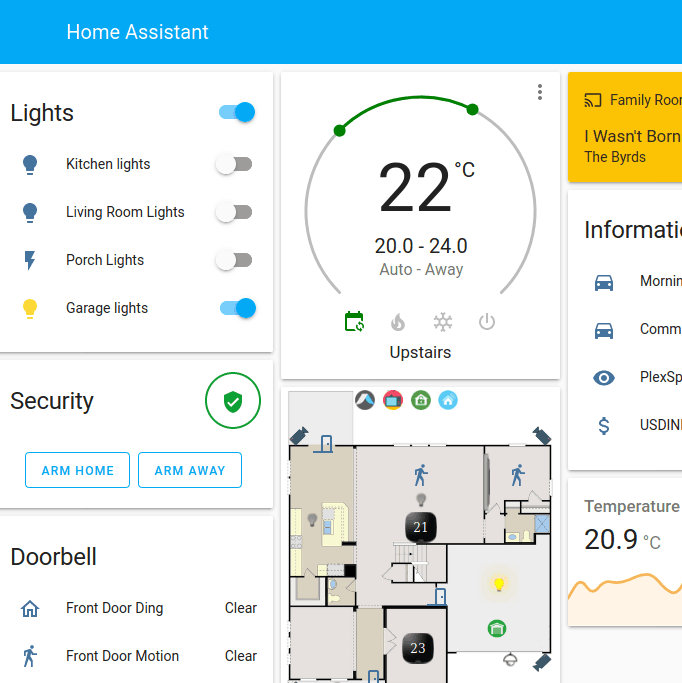When you have dozens (or even hundreds) of smart home devices – from smart speakers to smart bulbs, and smart plugs to cameras – you might be struggling to manage them all. After all, they’re probably all from different brands – meaning that you’ll probably have 10 different mobile apps!
And even if the devices all support Alexa (or Google Assistant) for voice control, you’ll probably struggle to remember the name of all your devices. Saying “Alexa, turn off smart plug… uhm… what’s the name..?” and constantly getting a response of “Sorry, I don’t understand” will be an all-too-common occurrence.
So what gives? What can you do to fix this unwieldy number of smart devices and apps?
Dedicated smart home owners usually use a smart home hub (or Home Assistant) to manage their smart home, but some instead stick to a single smart home brand or use Alexa/Google Assistant effectively to manage their smart home.
How you can end up with 100s of smart devices (and so dozens of phone apps)
The fact that there’s frequent sales on smart home devices (through the Amazon and Google Store, along with independent shops) means that it’s easy to keep buying just one more smart device. A new Echo Dot for the back bedroom, a new smart plug (“on sale at only $12”!!) for the living room and a few new smart bulbs for various rooms.
We’ve all done it. But before long, you’ll realize that you have dozens – or even hundreds – of smart devices. Whilst this might seem like I’m exaggerating, take a four bedroom house with two reception rooms and downlights in most rooms. You could easily end up with:
- 10 Echo or Google Home devices (4 in the bedrooms, 2 in the reception rooms, 1 in the study, 1 in the kitchen/diner, 1 in the garage and 1 in the family bathroom where there’s a ‘spa bath’).
- 2 smart doorbells (1 on the front door, 1 on the back door).
- 1 smart door lock (on your front door).
- 4 indoor smart cameras (dotted around the house).
- 5 outdoor smart cameras (covering your front, backyard and any side access points).
- 2 smart thermostats (as part of a multi-zone heating setup).
- 10 smart plugs (there’s quite a lot of devices you’ve found benefit from smart plugs over the years).
- 62 smart bulbs and accessories (I go into how an average house can hit this in my Philips Hue Bridge limit article).
- 1 smart alarm system.
- 10 smart sensors (to monitor water leaks and earthquakes).
That’s 107 smart devices. Plus if you’ve been buying most of these items in the sales, you’re also likely to have various different company’s products – and hence loads of different phone apps:
- The Alexa app for your Echo and some other devices.
- The Google Home app for the Google Nest Mini you purchased to try it out.
- The Ring app for most of your doorbells and cameras, and the alarm system.
- The Nest app for the back door Nest Hello doorbell.
- Nuki’s app for your smart door lock.
- ecobee’s app for your smart thermostats.
- TP-Link Kasa’s app for some of your smart plugs.
- The Gosund app for other smart plugs.
- The Wemo app for other smart plugs you picked up in the sales!
- The Hue app for most of your smart bulbs and accessories…
- … apart from the LIFX bulb app,
- and also the LUMIMAN app for some cheap color bulbs you picked up.
- The Govee app for your water leak sensors.
- The Aeotech app for your water leak and vibration/earthquake sensors.
That’s 14 separate phone apps to control your smart home, which will leave you looking like this guy:

Managing 107 smart devices across 14 phone apps would be nigh-on impossible, even if you use voice control via your Echo/Google Home devices to manage some of it as well.
So what are the solutions? Well, keep reading as I’ll cover four of the most common solutions. Each have their own pros and cons, meaning that not all will be best for your house.
Solution #1: stick to the same brand
The first potential solution is to stick to the same brand of smart devices, so that you at least only have a single phone app to manage everything in, and any voice commands you issue should all be the same style. By style, I mean that different company’s Alexa and Google Home skills can expect slightly different styles and formats of voice commands, meaning that sometimes you need to remember the correct wording for a command – for each brand of your smart device you own! By having just a single brand, the style (i.e. wording) of all your voice commands will be consistent.
Of course, this is easier said than done. SmartThings produce various sensors and a smart plug, along with their home hub, but anything else must be integrated into the SmartThings hub (more on this in solution 2).
Amazon produce a range of smart devices now (including smart speakers, and smart plugs), especially since they own Ring who produce smart cameras, doorbells and light bulbs. But there’s no smart thermostats and only a limited smart bulb range (via Ring), plus you need a separate Ring app anyway.
How about Google, who purchased Nest in 2014? Well, Google have a range of smart speakers (the Google Home range) along with loads of products from Nest – smart thermostats, indoor and outdoor cameras, a smoke/CO detector and a smart doorbell. Unfortunately the integration between Google Home and the Nest app is also poor: you still can’t add Nest Protect to the Google Home app, for example, even though Google are apparently aiming for all Nest products to be manageable within the Home app.
So the gist here is that you won’t be able to find a single smart device producer who can do everything that you’d like around your house. You can, however, try and limit what you buy to only a handful of companies – and then you at least only have 3-4 brands (and hence 3-4 mobile apps) instead of 14+ mobile apps!
Solution #2: use a smart hub
Smart devices don’t just ‘speak’ over WiFi: they can also communicate over technologies called Z-wave and ZigBee. They are a bit like Bluetooth, but with higher range and they’re more suited to smart homes. Both Z-wave and ZigBee can form a mesh, whereby one device can connect to another device (instead of the central hub) thereby increasing the strength and range of the overall network. One or more devices will then connect back to the central hub – the smart home hub – and so all (or most) of your smart devices can then effectively communicated with the hub, via the Z-wave/ZigBee mesh.
Smart hubs tend to support Z-wave and/or ZigBee, such as the SmartThings hub which supports both:

It also supports Bluetooth and WiFi, of course, meaning that pretty much any smart device can be connected to it.
The benefit of using a smart hub is that once all your devices are setup there, you can control them all in a central place: one smartphone app. In this sense, it’s a panacea compared to having 14 different smartphone apps or trying to remember the right commands to issue to your 107 smart devices!
The downside is that SmartThings doesn’t support every single smart device out there, especially since new products from unknown smart home producers are being released weekly. Having said that, SmartThings probably supports more devices than most smart hubs, and their compatibility list isn’t complete for some reason (for example, Ring Doorbells are also supported – but not listed in their previous list).
Other smart home hubs include:
- Hubitat, a home automation solution that aims to control your devices locally instead of relying on internet-based interactions all the time, and hence reliability, speed and privacy should be increased.
- The Sengled smart hub which supports up to 64 devices, but unfortunately only Sengled-produced smart devices.
- Wink’s smart home, which supports lots of different smart devices however Wink as a company have proven a bit unreliable over the years (with some downtimes and ownership changes), including randomly announcing earlier this year that all their products would stop working unless people started paying a $5 per month subscription fee.
They did eventually ‘change their mind’, but I can’t currently recommend Wink due to their recent unreliability. - The Amazon Echo Plus actually contains a ZigBee chip, meaning that it supports WiFi, Bluetooth and ZigBee devices. This includes Philips Hue light bulbs (which are ZigBee based).
The fact that Amazon are the largest smart home producer and seller currently means that their smart hub should be kept up to date with all new products for the foreseeable future, and integrate with an increasingly large range of devices going forward. Of course, the Echo Plus can’t communicate over Z-wave so some smart devices can’t be connected, but the majority will be supported.
The summary here is that many ardent smart home adopters use a smart home hub, especially since it centralizes the management and control of your smart home.
Solution #3: use Home Assistant
An alternative to going out and purchasing a ‘ready made’ smart home hub – one which might stop working in the future or start demanding $5 per month or your service will be cut off – is to make your own smart home hub!
So let’s say that you go out and buy one of these:

That’s a credit card sized computer called a Raspberry Pi (it’s the 2nd gen model, but the latest is the Pi 4).
You then go out and buy a ZigBee and/or Z-wave USB adapter, and hook it up to your computer network.
Finally you download Home Assistant onto an SD card and flash your Pi with it. Congratulations, you now have your own smart home hub that’s as powerful as the SmartThings hub, for less overall cost! Also Home Assistant is open source and is actively developed, meaning that it won’t stop working or not support new devices in the future. Yay!
Then you can setup your Home Assistant however you’d like, such that you have a powerful yet easy-to-use dashboard:

You can access this dashboard on a mobile, computer or tablet (unlike the SmartThings app which doesn’t have a computer based UI for some reason!).
Home Assistant is very flexible and configurable which is a double edged sword: you can setup lots of different smart home automations and management hooks, but at the same time it’s harder to setup than the smart hubs I explored in solution #2.
If you’re not technically minded at all, you may want to avoid Home Assistant. But if you have some technical knowledge and are looking for a slight challenge, HA could be perfect for you.
Solution #4: use Alexa/Google Assistant/HomeKit effectively
A final solution is to disregard smart hubs and trying to stick to the same smart home brand, but instead do your best to use Alexa (or Google Assistant, or HomeKit, etc) to manage your smart home 100%.
Some really important things to do in this case are:
- Use unique and descriptive, yet easy-to-say names for all your smart devices. You don’t want two devices that sound really similar, otherwise Alexa will probably get confused at times and control one device when you actually wanted to control another.
It might be helpful to put the room name in the name of the device, along with the device itself – e.g. “Kitchen Dot” or “Bedroom 2 Side Lamp”. - Make sure that any devices you buy are compatible with Alexa/Google Assistant. This might seem obvious, but if you decide to use Google’s smart home ecosystem, you don’t want to accidentally purchase any smart devices which only support Alexa and HomeKit.
- Consider mounting a tablet on a wall-mounted tablet stand, and install the Alexa or Google Home app on there. This can act as a smart home control panel, like you’d see in the movies. It’s actually fairly easy to get setup – the tablet stand is the only unusual thing here.
- Use lots of automation routines. I love that you can create routines (or ‘automation rules’) really easily in smart home apps. For example in Alexa, it’s very straightforward – you have the trigger (such as when someone says something, or a smart device does something) and then an action (where you setup one or more things to happen in response to the trigger):

If you plan on using Alexa (the app and voice control) for your smart home management, I’d strongly recommend the Echo Plus because any ZigBee based smart devices can then be managed by your Plus too.

If you have any questions, feedback or suggestions about this article, please leave a comment below. Please note that all comments go into a moderation queue (to prevent blog spam). Your comment will be manually reviewed and approved by Tristan in less than a week. Thanks!